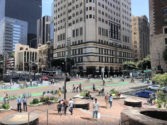
September 02, 2021
Electric Buses are Critical to Zero-Emission Mobility in Los Angeles
Since 2019, ITDP has been working in one of North America’s most notoriously car-centered and sprawled cities: Los Angeles. Collaborating with local officials to promote policies like better bus service and the creation of a zero emission area, among other initiatives, ITDPs work focuses on addressing the climate crisis, equity concerns, and access to economic opportunities.
Los Angeles residents lose over 100 hours each year due to traffic congestion. For decades, freeways, single-family neighborhoods, and parking have spread outward and consumed more land. It’s both difficult to get around Los Angeles with a car, due to frequent traffic congestion, and also difficult to get around without a car as jobs, housing, services and recreation are built only for car access.
In 2017, Mayor Eric Garcetti committed to dedicate a major area of the city as zero-emission by 2030 through the C40 Cities Green and Healthy Street Declaration. ITDP has been working with the Mayor’s Office to ensure that a zero-emission area is created in a neighborhood of high air pollution and reduces the amount of vehicles through improvements to walking and cycling infrastructure and high-quality, zero-emission bus service. A zero emission area includes reduced private vehicles and emission-free travel. Electric buses are a key component for a zero-emission area in Los Angeles, the largest city in the county.
Renderings envision what ZEA could look like in Los Angeles
ITDP has been working to improve bus conditions in Los Angeles through the Better Buses for LA coalition led by Investing in Place, the Beautiful Broadway coalition, and direct engagement with LA Metro and the City of Los Angeles. Improved bus service and bus rapid transit (BRT) implementation can transform the rider experience for better access to jobs, education, and services while also tackling regional traffic congestion. When planned with high standards, BRT can move thousands of travelers quickly and comfortably. ITDP has been working with local partners to advocate for an integrated BRT network with dedicated lanes, center-running stations, and protected bike infrastructure. ITDP has called for dual side doors on buses, a feature that improves bus service by removing potential curbside conflicts for bike use, micromobility and outdoor parklet dining.

While bus riders in Los Angeles reflect the region’s diversity, many have few other transportation options. A majority are from low-income households and are often people of color and increasingly women. Many people who ride the bus do so because they don’t have reliable access to a car. Nonetheless, poor bus service and infrastructure have led to long waits, delays, hot and uncovered bus stops, multiple transfers, and safety and sanitation concerns. Despite the challenges of taking public transit and walking in Los Angeles, almost a million people took public transit in the county on a weekly basis—over 850,000 of whom were bus riders—before the COVID-19 pandemic started in 2020. These challenges have in part led to a steady decline in bus ridership over the past decades, by some estimates up to 25%.
Implementing transformative electric bus corridors in a region of ten million comes with challenges, yet there is momentum for change. Planning for electric buses, especially BRT buses, requires attention to their particular operational requirements. ITDP has been working with local partners to advocate for an integrated BRT network with dedicated lanes, center-running stations, and protected bike infrastructure. This includes the recent implementation of bus-only lanes in key areas of downtown Los Angeles, a significant overhaul of the bus network through the NextGen Bus Plan, and a pending state bill that will allow for camera enforcement of bus-only lanes. In addition, several years ago, voters in the county agreed to a sales tax that will bring billions of dollars for public transit projects and service over the decades and includes funding for up to four BRT lines by the 2028 Los Angeles Olympics. With greater focus on sustainable mobility and strong vision for buses, Los Angeles is ushering in a new era of investing in the bus—a flagship initiative necessary to make zero emission mobility a reality.


